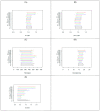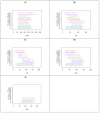Reference Intervals for Coagulation Parameters in Developmental Hemostasis from Infancy to Adolescence
- PMID: 36292241
- PMCID: PMC9601585
- DOI: 10.3390/diagnostics12102552
Reference Intervals for Coagulation Parameters in Developmental Hemostasis from Infancy to Adolescence
Abstract
Background: The objective of this study was to establish the age and sex-dependent reference intervals for coagulation assays evaluated in healthy children, ranging from 0 days to 16 years old. Methods: PT, aPTT, Fibrinogen (functional), Antithrombin activity, Protein C anticoagulant activity, Protein S free antigen, Thrombin time, D-Dimer, Von Willebrand Factor antigen, Lupus anticoagulant (screening), extrinsic and intrinsic pathway factors, and activated Protein C resistance were evaluated using STA-R Max2. Results: A total of 1280 subjects (671 males and 609 females) were divided into five groups, according to their age: 0-15 days (n = 280, 174 M and 106 F), 15-30 days (n = 208, 101 M and 107 F), 1-6 months (n = 369, 178 M and 191 F), 6-12 months (n = 214, 110 M and 104 F), and 1-16 years (n = 209, 108 M and 101 F). The 95% reference intervals and the 90% CI were established using the Harrell-Davis bootstrap method and the bootstrap percentile method, respectively. Conclusions: The present study supports the concept that adult and pediatric subjects should be evaluated using different reference intervals, at least for some coagulation tests, to avoid misdiagnosis, which can potentially lead to serious consequences for patients and their families, and ultimately the healthcare system.
Keywords: coagulation; pediatrics; reference interval.
Conflict of interest statement
The authors declare no conflict of interest.
Figures






Similar articles
-
Dynamic reference intervals for coagulation parameters from infancy to adolescence.Clin Chim Acta. 2018 Jul;482:124-135. doi: 10.1016/j.cca.2018.04.003. Epub 2018 Apr 4. Clin Chim Acta. 2018. PMID: 29626437
-
Coagulation Testing in the Core Laboratory.Lab Med. 2017 Nov 8;48(4):295-313. doi: 10.1093/labmed/lmx050. Lab Med. 2017. PMID: 29126301 Review.
-
Maternal and cord blood hemostasis at delivery.J Perinat Med. 1997;25(1):55-61. doi: 10.1515/jpme.1997.25.1.55. J Perinat Med. 1997. PMID: 9085204
-
Reference intervals and method optimization for variables reflecting hypocoagulatory and hypercoagulatory states in dogs using the STA Compact automated analyzer.J Vet Diagn Invest. 2009 Nov;21(6):803-14. doi: 10.1177/104063870902100606. J Vet Diagn Invest. 2009. PMID: 19901280
-
[Interpretation of hemostatic and fibrinolytic markers].Rinsho Byori. 2011 Oct;59(10):970-7. Rinsho Byori. 2011. PMID: 22184880 Review. Japanese.
Cited by
-
Hemostasis Laboratory Diagnostics in Newborns.J Clin Med. 2025 Jul 17;14(14):5068. doi: 10.3390/jcm14145068. J Clin Med. 2025. PMID: 40725765 Free PMC article. Review.
-
Plasminogen Activator Inhibitor-1 and Vitamin D Association in the Overweight and Obese Pediatric Population.Nutrients. 2023 Aug 25;15(17):3717. doi: 10.3390/nu15173717. Nutrients. 2023. PMID: 37686748 Free PMC article.
-
Complete Blood Count Reference Intervals for Children Aged Less Than 1 to 12 Years in the Northern Region of Ghana.Biomed Res Int. 2024 May 10;2024:6607281. doi: 10.1155/2024/6607281. eCollection 2024. Biomed Res Int. 2024. PMID: 38764534 Free PMC article.
References
LinkOut - more resources
Full Text Sources

